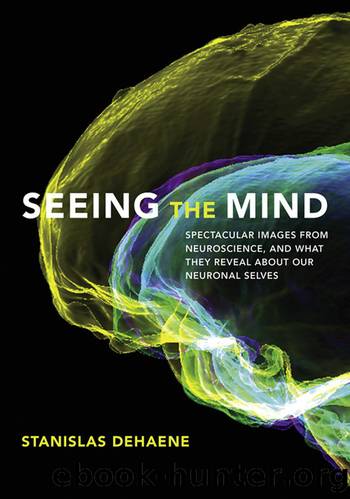Seeing the Mind by Stanislas Dehaene

Author:Stanislas Dehaene [Dehaene, Stanislas]
Language: eng
Format: epub
Tags: brain; mind; cognition; consciousness; intelligence; artificial intelligence; neuroscience; neurons; functional MRI; neural network
Publisher: MIT Press
Published: 2023-09-22T00:00:00+00:00
NUMBER NEURONS
Discovery of number neurons in the macaque monkey. The regions in red, in the prefrontal and parietal cortex, contain a large proportion of neurons tuned to a given number of objects, here between one and five. Research carried out by Andreas Nieder and his colleagues, first at MIT, then at the University of Tübingen in Germany.
Learning to read is clearly the prerogative of the human species, but what about mathematics? Is basic math accessible to other animals? To find out, Andreas Nieder and Earl Miller examined whether macaque monkeys understand the concept of number.29 They trained them on a same/different judgment: on each trial, the animal saw two sets of objects, one after the other, and had to decide whether they shared the same number.
First finding: after some training, the monkeys performed this task remarkably well. They succeeded with a great variety of configurations, and could clearly focus solely on number. Their only problem was to answer âsameâ when the two numbers were close, like 4 and 5. Thus, monkeys cannot count, but can only estimate an approximate quantity of items.
Second finding: the macaque brain contains neurons tuned to number. Each of these cells responds to a certain number of objects. Some fire only when the animal sees one object; others prefer two; still others are stimulated by seeing three, four, or five objects. Each neuron possesses a favorite number, but their tuning is not perfectly sharp: neurons that fire the most to four objects, for example, also respond to three or five objects. Again, monkeysâ number sense is approximate.
A similar number sense is present in humans.30 We too are capable of estimating a number without counting, and our parietal cortex contains a number map with different sectors tuned to different quantities of objects.31 Single neurons similar to those of monkeys have even been found in the human hippocampus.32
None of this, by the way, is unique to primates. Many species, without any special training, pay attention to the numbers around them. Number neurons virtually identical to those of monkeys have even been observed in crows.33 Basic arithmetic is so useful for survival, whether to find as much food as possible or to check how many conspecifics are in a coalition, that many distinct animal lineages seem to have evolved the same sort of brain circuit for number sense; alternatively, number may be such a fundamental concept that the brain has paid attention to it for hundreds of millions of years.
Is there nothing special, then, about us humans? Of course there is: we are the only animal that manages to overcome the fuzziness of this approximate number sense. Using symbols, we develop a precise and rigorous arithmetic that serves as the foundation for the edifice of mathematics. The acquisition of a language of mathematics considerably amplifies the initial potential of our brain.
Download
This site does not store any files on its server. We only index and link to content provided by other sites. Please contact the content providers to delete copyright contents if any and email us, we'll remove relevant links or contents immediately.
| Administration & Medicine Economics | Allied Health Professions |
| Basic Sciences | Dentistry |
| History | Medical Informatics |
| Medicine | Nursing |
| Pharmacology | Psychology |
| Research | Veterinary Medicine |
Periodization Training for Sports by Tudor Bompa(8173)
Why We Sleep: Unlocking the Power of Sleep and Dreams by Matthew Walker(6620)
Paper Towns by Green John(5092)
The Immortal Life of Henrietta Lacks by Rebecca Skloot(4528)
The Sports Rules Book by Human Kinetics(4299)
Dynamic Alignment Through Imagery by Eric Franklin(4119)
ACSM's Complete Guide to Fitness & Health by ACSM(3991)
Kaplan MCAT Organic Chemistry Review: Created for MCAT 2015 (Kaplan Test Prep) by Kaplan(3940)
Introduction to Kinesiology by Shirl J. Hoffman(3726)
Livewired by David Eagleman(3686)
The Death of the Heart by Elizabeth Bowen(3554)
The River of Consciousness by Oliver Sacks(3543)
Alchemy and Alchemists by C. J. S. Thompson(3452)
Bad Pharma by Ben Goldacre(3358)
Descartes' Error by Antonio Damasio(3232)
The Emperor of All Maladies: A Biography of Cancer by Siddhartha Mukherjee(3070)
The Gene: An Intimate History by Siddhartha Mukherjee(3050)
The Fate of Rome: Climate, Disease, and the End of an Empire (The Princeton History of the Ancient World) by Kyle Harper(3007)
Kaplan MCAT Behavioral Sciences Review: Created for MCAT 2015 (Kaplan Test Prep) by Kaplan(2941)
